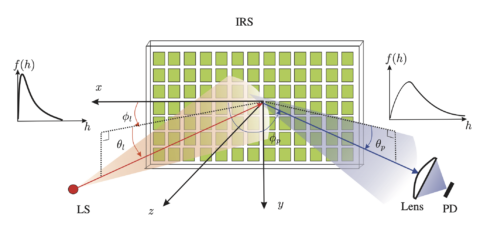Channel Fading in IRS-assisted FSO Links
Free space optical (FSO) systems, due to their large bandwidth and secure and cost-efficient data transmission, are considered as suitable candidates for next generation wireless communication networks and beyond. However, they require a line-of-sight (LOS) connection between transmitter (Tx) and receiver (Rx). This limitation can be relaxed by using optical intelligent reflecting surfaces (IRSs). IRSs employ a phase shift profile to redirect, collimate, or focus the beam at the receiver lens. The end-to-end FSO channel is characterized by atmospheric loss, atmospheric turbulence, and geometric and misalignment loss (GML). In point-to-point FSO links, the variations of the refractive index due to temperature and pressure change along the propagation path cause atmospheric turbulence. Inserting an IRS in an FSO link, which changes the phase profile of the incident beam, affects the statistics of the atmospheric turbulence. For example, a focusing phase shift profile across the IRS can decrease the random variations of the received signal due to atmospheric turbulence and improve the end-to-end performance. In this thesis, first we aim to simulate the atmospheric turbulence in point-to-point FSO links. Then, we model and simulate the impact of different IRS phase shift profiles on the atmospheric turbulence and study the statistics of the end-to-end channel.
Guidelines for the project
- Conduct a literature survey on FSO and IRS systems
- Develop a simulator for atmospheric turbulence fading
- Provide an analytical statistical turbulence model for IRS-assisted FSO links
- Simulate of the proposed model in Matlab
Prerequisites
- Interest in communications and signal processing
- Basic knowledge of digital and mobile communication systems
- Experience in Matlab
- Basics of μC programming
Contact

